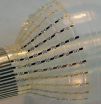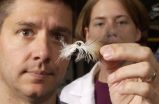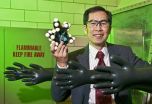(Press-News.org) Durham, NC —For the vast majority of plants and animals, the 'bigger is better' view of evolution may not be far off the mark, says a new broad-scale study of natural selection. Organisms with bigger bodies or faster growth rates tend to live longer, mate more and produce more offspring, whether they are deer or damselflies, the authors report.
Researchers working at the National Evolutionary Synthesis Center compiled and reviewed nearly 150 published estimates of natural selection, representing more than 100 species of birds, lizards, snakes, insects and plants. The results confirm that for most plants and animals, larger body size and earlier seasonal timing — such as earlier breeding, blooming or hatching —confer significant survival advantages.
"It's a very widespread pattern," said co-author Joel Kingsolver of the University of North Carolina at Chapel Hill.
What's puzzling, the authors say, is not why the 'bigger is better' model of evolution is so common, but why the 'Goldilocks' model is so rare: If organisms are supposedly well-adapted to their particular circumstances, then why is it so seldom the case that the individuals that survive and reproduce the best are the ones that are not too small, nor too big, but just right?
A classic example is human birth weight. Newborns of intermediate size are more likely to survive than newborns that are extremely large or extremely small. In lieu of driving organisms to be bigger and faster over time, the 'Goldilocks' model — also known as stabilizing selection — favors moderation, the authors explained. But for the vast majority of organismal traits, this pattern is the exception, not the rule. "Rarely is it the case that the individuals that survive and reproduce the best are the ones in the middle," Kingsolver said.
The result is puzzling because the conventional wisdom is that most creatures are well adapted to the environments in which they live. "When we look at nature, we see all these amazing ways species are well-adapted to their lifestyles and habitats," Kingsolver said. "Yet the organisms that are bigger, faster, still do the best in terms of survival and reproduction. Why aren't they already just the right size or speed, or pretty close to it?" he asked.
The authors explored three possible explanations. One possibility, they explained, is that evolving to be bigger, faster, or flashier comes at a cost. "A trait that's good for reproduction or fertility may be bad for survival — there may be a tradeoff," Kingsolver said. "In guppies, for example, brightly colored males have greater mating success, but they're also more likely to be eaten by predators," said co-author Sarah Diamond, currently a postdoctoral researcher at North Carolina State University.
Another possibility is that environments simply change from one season to the next, such that the traits that confer the greatest advantage change over time. "In Darwin's finches, for example, there are years where large-beaked birds have an advantage because large seeds are more abundant, and years where smaller-beaked birds do better because small seeds are more abundant," Diamond said.
A third possibility is that natural selection drives one trait in one direction, while simultaneously driving another, genetically correlated trait in the opposite direction. "For example it may be good for flying insects to evolve larger wings and smaller bodies for more efficient flight," Kingsolver said, "but if insects with larger wings also have larger bodies, they can't evolve both."
The third explanation frequently limits the evolution of body size, the authors found, but not traits related to timing, or body shape, or coloration. "Size is the one case where correlated selection is important," Kingsolver said.
###
The findings appear in the March 2011 issue of American Naturalist.
CITATION: Kingsolver, J. and S. Diamond (2011). "Phenotypic selection in natural populations: what limits directional selection?" American Naturalist 177(3): 346-357. doi:10.1086/658341.
Study data are available in the Dryad Digital Repository at http://datadryad.org/handle/10255/dryad.7997.
The National Evolutionary Synthesis Center (NESCent) is a nonprofit science center dedicated to cross-disciplinary research in evolution. Funded by the National Science Foundation, NESCent is jointly operated by Duke University, The University of North Carolina at Chapel Hill, and North Carolina State University. For more information about research and training opportunities at NESCent, visit www.nescent.org.
Evolution drives many plants and animals to be bigger, faster
2011-03-08
ELSE PRESS RELEASES FROM THIS DATE:
People would rather let bad things happen than cause them, especially if someone is watching
2011-03-08
People are more comfortable committing sins of omission than commission—letting bad things happen rather than actively causing something bad. A new study published in Psychological Science, a journal of the Association for Psychological Science, suggests that this is because they know other people will think worse of them if they do something bad than if they let something bad happen.
"Omissions and commissions come up relatively frequently in everyday life, and we sometimes puzzle over them," says moral psychologist Peter DeScioli of Brandeis University, who conducted ...
Popular drugs for common male health problems can affect their sexual health
2011-03-08
A new study published in The Journal of Sexual Medicine reveals that, for the first time, 5a-reductase inhibitors commonly used to treat urinary problems in patients with benign prostatic hyperplasia (BPH) and found in popular medications to treat hair loss, can produce, persistent erectile dysfunction (ED), depression and loss of libido, even after the medication has been discontinued.
Researchers led by Abdulmaged M. Traish, MBA, PhD, of Boston University School of Medicine, examined data reported in various clinical studies from the available literature concerning ...
Stretchable balloon electronics get to the heart of cardiac medicine
2011-03-08
CHAMPAIGN, Ill. — Cardiologists may soon be able to place sensitive electronics inside their patients' hearts with minimal invasiveness, enabling more sophisticated and efficient diagnosis and treatment of arrhythmias.
A team of materials scientists, mechanical and electrical engineers, and physicians has successfully integrated stretchable electronics technology with standard endocardial balloon catheters. Led by John A. Rogers, the Lee J. Flory-Founder Chair in Engineering at Illinois, the team published its work in the March 6 online edition of Nature Materials.
The ...
New perspective diminishes racial bias in pain treatment
2011-03-08
MADISON — Years of research show black patients getting less treatment in the American health care system than their white counterparts, but a new study suggests that a quick dose of empathy helps close racial gaps in pain treatment.
College students and nurses went to greater lengths to ease the pain of members of their own race in a study led by Brian Drwecki, a psychology graduate student at the University of Wisconsin-Madison.
"I want to be very clear about this: We're not saying health care professionals are racist," Drwecki says. "This is not racism. Racism is ...
DNA better than eyes when counting endangered species
2011-03-08
WEST LAFAYETTE, Ind. - Using genetic methods to count endangered eagles, a group of scientists showed that traditional counting methods can lead to significantly incorrect totals that they believe could adversely affect conservation efforts.
Andrew DeWoody, a professor of genetics at Purdue University; Jamie Ivy, population manager at the San Diego Zoo; and Todd Katzner, a research assistant professor at the University of West Virginia, found that visual counts of imperial and white-tailed sea eagles in the Narzum National Nature Reserve of Kazakhstan significantly underestimated ...
Web use doesn't encourage belief in political rumors, but e-mail does
2011-03-08
COLUMBUS, Ohio – Despite the fears of some, a new study suggests that use of the internet in general does not make people more likely to believe political rumors.
However, one form of internet communication – e-mail – does seem to have troubling consequences for the spread and belief of rumors.
"I think a lot of people will be surprised to learn that using the internet doesn't necessarily promote belief in rumors. Many people seem to think that's self-evident," said R. Kelly Garrett, author of the study and assistant professor of communication at Ohio State University.
"The ...
UCLA researchers use 'nano-Velcro' technology to improve capture of circulating cancer cells
2011-03-08
Circulating tumor cells, which play a crucial role in cancer metastasis, have been known to science for more than 100 years, and researchers have long endeavored to track and capture them. Now, a UCLA research team has developed an innovative device based on Velcro-like nanoscale technology to efficiently identify and "grab" these circulating tumor cells, or CTCs, in the blood.
Metastasis is the most common cause of cancer-related death in patients with solid tumors and occurs when these marauding tumor cells leave the primary tumor site and travel through the blood ...
Story tips from the US Department of Energy's Oak Ridge National Laboratory March 2011
2011-03-08
CYBERSECURITY -- Software agents on assignment . . .
Tracking and protecting information stored on an organization's network could be more secure with a system developed by a team led by Justin Beaver of Oak Ridge National Laboratory's Computational Sciences and Engineering Division. The challenge arises when an organization has documents that are being copied, excerpted, changed and stored in various forms across the organization's network. Host Information Value Engine, dubbed HIVE, solves the problem by dispatching software agents that automatically and quickly review ...
AGU journal highlights -- March 7, 2011
2011-03-08
1. California rapidly depleting Central Valley groundwater
Groundwater is being depleted in California's Central Valley at a rapid rate, according to data from the Gravity Recovery and Climate Experiment (GRACE) satellite. Famiglietti et al. analyze 78 months of GRACE data covering October 2003 to March 2010 to estimate water storage changes in California's Sacramento and San Joaquin River basins. They find that the basins are losing water at a rate of about 30 millimeters (1.2 inches) per year equivalent water height, or a total of about 30 cubic kilometers (7.2 cubic ...
Iowa State, Ames Lab researcher hunts for green catalysts
2011-03-08
AMES, Iowa – L. Keith Woo is searching for cleaner, greener chemical reactions.
Woo, an Iowa State University professor of chemistry and an associate of the U.S. Department of Energy's Ames Laboratory, has studied catalysts and the chemical reactions they affect for more than 25 years. And these days, his focus is on green catalysis.
That, he said, is the search for catalysts that lead to more efficient chemical reactions. That could mean they promote reactions at lower pressures and temperatures. Or it could mean they promote reactions that create less waste. Or it ...


